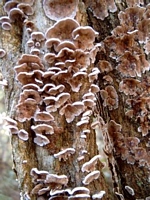|
 Chondrostereum purpureum Chondrostereum purpureum
SynonymsStereum purpureum
Thelephora purpurea
BiostatusPresent in region - Exotic
Images (click to enlarge)
Owner: P.K. Buchanan |
Article: Gadgil, P.D. (in association with Dick, M.A.; Hood, I.A.; Pennycook, S.R.) (2005). Fungi on trees and shrubs in New Zealand. Fungi of New Zealand. Ngā Harore o Aotearoa 4: xi + 437 p. Hong Kong: Fungal Diversity Press.
Description: Type: Caulicolous Fungi; Description: Basidiomata fully resupinate to semipileate with pilei which project up to 40 mm from the substrate, forming patches up to 100 mm long. Pileus surface tomentose, greyish white, indistinctly zoned, margin lighter. Pore surface purplish to dark violaceous, when old brown violaceous, smooth to slightly wrinkled, margin slightly fringed. Context 1–2 mm thick, in cross section a dark line separating the context from the pileus surface is clearly visible. Hyphal system monomitic. Cystidia sparse, fusoid or obtuse, some encrusted, 60–70 × 5–8 μm, hyaline. Basidiospores ellipsoidal to cylindrical, 5–8 × 2–4 μm, smooth, hyaline, non-amyloid.
Distribution: Distribution: Northland, Auckland, Coromandel, Waikato, Bay of Plenty, Taranaki, Taupo, Rangitikei, Wanganui, Wellington, Gisborne, Hawkes Bay, Wairarapa, Nelson, Buller, Marlborough Sounds, Marlborough, Kaikoura, Mid Canterbury, Southland, Chatham Islands.; 1st Record: Blackmore (1894: as ‘silver blight’).
Article: Dingley, J.M. (1969). Records of plant diseases in New Zealand. New Zealand Department of Scientific and Industrial Research, Bulletin 192: 298 p. Wellington:.
Article: Cunningham, G.H. (1963). The Thelephoraceae of Australia and New Zealand. New Zealand Department of Scientific and Industrial Research, Bulletin 145: 359 p. Wellington:.
Description: Hymenophore annual, membranous, pileate,
sessile. Pilei effused-reflexed or flabelliform, solitary or more usually
laterally connate and imbricate, sometimes with a broad resupinate base and
reflexed margins, occasionally resupinate, 3-10 mm radius, 3-15 mm wide, when
connate forming linear areas to 20 cm long; pileus surface coarsely tomentose,
concentrically sulcate and zoned, usually straw colour or tan, sometimes dingy
grey, occasionally with denuded zones; margin thinning out, concolorous, entire,
inturned; hymenial surface even, sometimes scantily rugulose, ochre, pallid plum
or purple, occasionally creviced when old. Context white, 0.3-0.5 mm thick, a
dense layer of radiately arranged parallel hyphae with a loosely intertwined
zone beneath the hymenium containing vesicles, and a coloured cortex from which
arise the abhymenial hairs; skeletal hyphae 3.5-4 µm diameter, walls 0.5-1 µm
thick; generative hyphae 2.5-3 µm diameter, walls 0.2 µm thick, with clamp
connections. Vesicles developing in a zone beneath the hymenial layer, arising
from generative hyphae, pyriform, 12-18 µm diameter, carried on stout pedicels.
Hymenial layer to 50 µm deep, a dense palisade of basidia, paraphyses, and
sometimes paraphysate hyphae. Basidia subclavate, 16-24 x 5-6 µm, bearing 4
spores; sterigmata slender, erect, to 6 µm long. Paraphyses subelavate, 12-18 x
4-5 µm. Cystidioid hyphae absent. Paraphysate hyphae cylindrical, to 5 µm
diameter, projecting to 35 µm. Spores elliptical, or with one side slightly
flattened, obliquely apiculate, 5.5-8 x 2.5-3.5 µm, walls smooth, hyaline, 0.2
µm thick.
Habitat: HABITAT: Crowded
and often imbricate upon living or dead trunks and branches.
Distribution: DISTRIBUTION: Cosmopolitan.
Notes: Readily recognised by the zone
of pyriform vesicles beneath the hymenial layer, coarsely tomentose small pilei,
often connate and imbricate, dimitic hyphal system with clamp connections in the
generative hyphae, and small elliptical, obliquely apiculate spores. Vesicles
are readily seen in growing specimens, but in old material collapse and lose
their contents or disappear, then leaving cavities in the context. Occasional
vesicles are flexuous-cylindrical, traverse the hymenial layer, and simulate
gloeocystidia. A coloured cortex is present beneath abhymenial hairs, as in
S. hirsutum, but cystidioid hyphae are wanting. Paraphysate hyphae are
present in some collections, absent from others, so are without specific
significance. The hyphal system is dimitic. Skeletal hyphae, although of about
the same diameter as generative, differ in that walls are thicker, septa scanty,
and clamp connections wanting. Commonly some shade of purple, the hymenium often
exhibits other colours, such as ochre, pallid plum, or grey. In some plants the
context, and especially the hymenial layer, appears zoned, the condition
probably representing periods of seasonal growth. S. purpureum induces
a silver leaf disease of many cultivated fruits, in New Zealand being common on
apples, apricots, cherries, gooseberries, peaches, pears, plums, and
raspberries. Although usually found in introduced hosts, it is not confined to
these since in the herbarium are collections from endemic New Zealand plants,
two on branches of Nothofagus cliffortioides, a third on stems of
Pittosporum tenuifolium. In most collections spores are 5.5-6 x 2.5-3
µm but in several specimens may reach a length of 8 µm. Large-spored forms are
not associated with any other noteworthy feature. The species was made the type
of Chondrostereum by Pouzar (1959, p. 17).
|